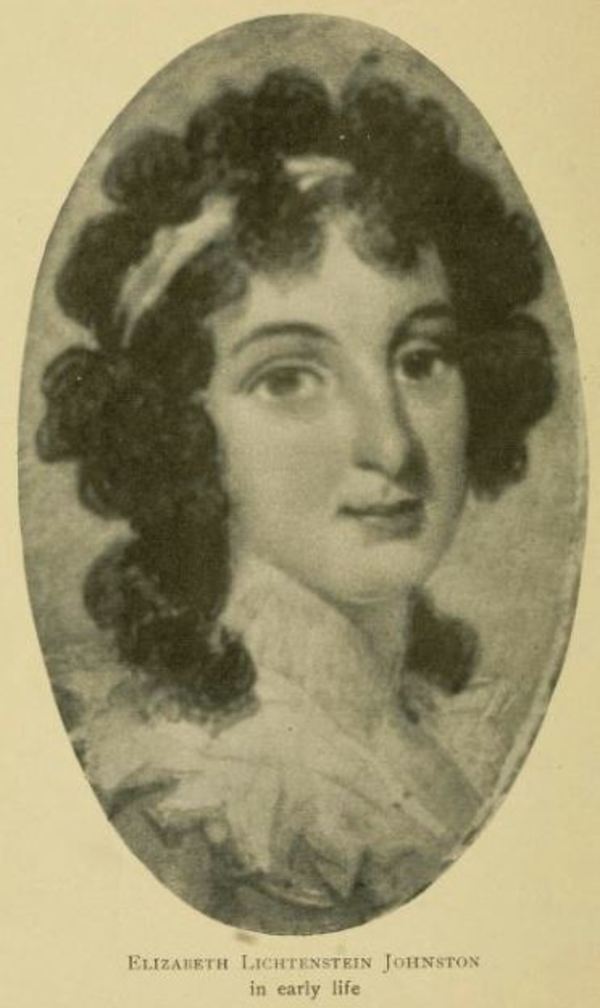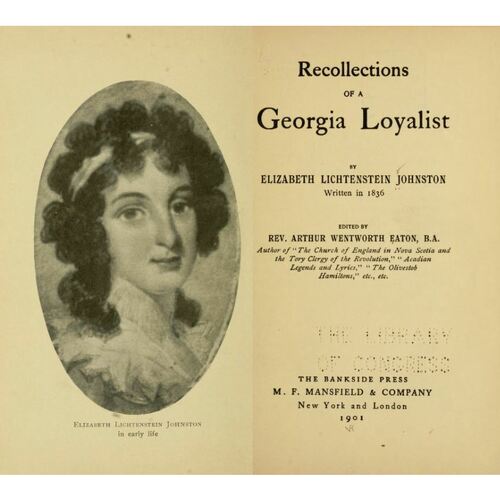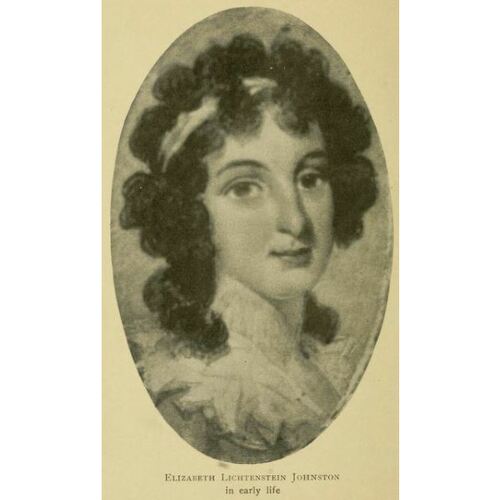
Source: Link
LICHTENSTEIN, ELIZABETH (Johnston), author; b. 28 May 1764 in Little Ogeechee, Ga, only child of John G. Lightenstone and Catherine Delegal; m. 21 Nov. 1779 William Martin Johnston in Savannah, Ga, and they had ten children, only three of whom survived her; d. 24 Sept. 1848 in Halifax.
Elizabeth Lichtenstein’s father, a native of Cronstadt (Kronstadt, U.S.S.R..), immigrated to Georgia some time in the mid 18th century, and anglicized his surname to Lightenstone. He served Governor Sir James Wright in several capacities and during the American Revolutionary War was a guide and adviser to the Georgia Light Dragoons. Because of her father’s frequent absences from home, Elizabeth was largely brought up by her mother and, on her death, by a great-aunt, both of whom apparently stimulated her interest in reading and writing. In 1776 her father left for Nova Scotia. The 12-year-old Elizabeth successfully presented to the board of commissioners in Savannah a petition, drawn up by her grandfather, asking for possession of her father’s estate, which was in danger of being confiscated because of his loyalist activities.
In 1779 Elizabeth married William Martin Johnston, a captain in the New York Volunteers, and shortly afterwards she moved with him to New York. They later returned to Savannah, and then early in 1782 went to Charleston, S.C. When that town was evacuated by the British in December, she and her children went to St Augustine (Fla). In the one and a half years they spent there she enjoyed the best health of her life, as she later commented. After the Floridas were ceded to Spain in 1784, the entire family sailed for Scotland where William completed the medical studies that the war had interrupted. In 1785 he began to practise in Kingston, Jamaica, where his family joined him the next year. Until 1806 Elizabeth and the children often returned to Great Britain, for reasons of health. Late that year they went to Nova Scotia. On their arrival, they learned that William had died of dropsy. Elizabeth had to return to Jamaica to settle her husband’s estate, but was back in Nova Scotia by 1810. She first took up residence in Annapolis Royal near her father and daughter, Elizabeth Wildman, who had married Thomas Ritchie* in 1807, and later moved to Halifax.
In Nova Scotia Elizabeth had a relatively stable life. Although she frequently travelled between Annapolis and Halifax to visit friends and family, she only once left the colony. In 1824 she went to England to have cataract surgery. Twelve years later, at the age of 72, she wrote her memoirs, largely for the sake of her grandchildren. Recollections of a Georgia loyalist has significance because its author had experienced the disruptions of the loyalist migrations and belonged to an important colonial family. She died in Halifax on 24 Sept. 1848 and was buried at Camp Hill Cemetery.
From Recollections emerges Elizabeth’s deep religious faith, which had a puritanical tone. She was convinced that all the bitter sorrows of her life were punishment for her sins. The memoirs are largely an account of the personal problems of the author and her family, with much attention to illness and little interest in the ideology or military events of the American revolution, although she briefly mentions hardships of loyalists in Savannah and the turning against her father which showed “the violence with which civil wars are entered upon.” Elizabeth seems to have accepted that a woman’s place was in the home, and it is evident that despite her being well read and well educated for her day, her life revolved around her immediate household.
Elizabeth’s children married into some of the most prominent families in Nova Scotia, such as the Ritchies, the Almons, and the Pryors. One of her sons, James William Johnston*, became the leader of the Conservative party in the colony, and another, John, was a member of the House of Assembly.
Elizabeth Lichtenstein Johnston’s Recollections of a Georgia loyalist was edited by Arthur Wentworth Hamilton Eaton* and published in New York and London in 1901.
Halifax County Court of Probate (Halifax), Estate papers, no.292 (Elizabeth Lichtenstein Johnston) (mfm. at PANS). PRO, AO 12/4–5, 12/59, 12/99, 12/109, 12/125–28 (mfm. at PAC); AO 13, bundle 36 (mfm. at PANS). Church Times (Halifax), 29 Sept. 1848. W. H. Siebert, “The legacy of the American revolution to the British West Indies and Bahamas . . . ,” Ohio State Univ., Bull. (Columbus), 17 (1913), no.27.
Cite This Article
Julie Morris and Wendy L. Thorpe, “LICHTENSTEIN, ELIZABETH (Johnston),” in Dictionary of Canadian Biography, vol. 7, University of Toronto/Université Laval, 2003–, accessed March 31, 2025, https://www.biographi.ca/en/bio/lichtenstein_elizabeth_7E.html.
The citation above shows the format for footnotes and endnotes according to the Chicago manual of style (16th edition). Information to be used in other citation formats:
| Permalink: | https://www.biographi.ca/en/bio/lichtenstein_elizabeth_7E.html |
| Author of Article: | Julie Morris and Wendy L. Thorpe |
| Title of Article: | LICHTENSTEIN, ELIZABETH (Johnston) |
| Publication Name: | Dictionary of Canadian Biography, vol. 7 |
| Publisher: | University of Toronto/Université Laval |
| Year of revision: | 1988 |
| Access Date: | March 31, 2025 |




